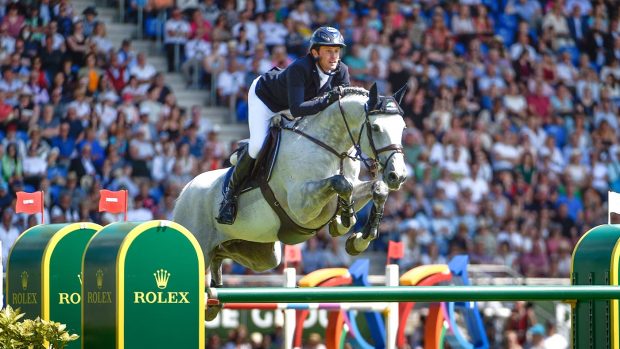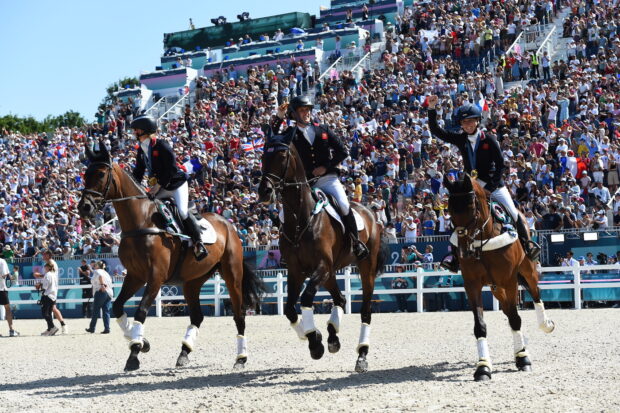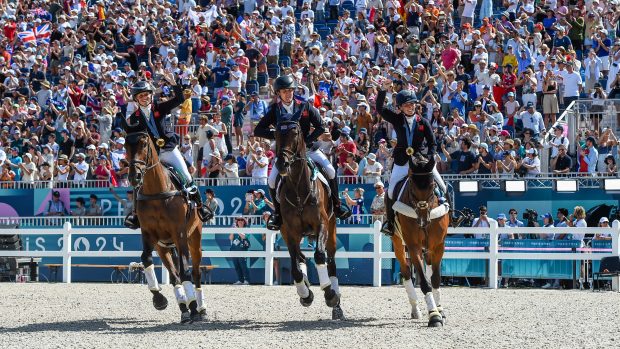The Olympic dressage format which will be used at the Paris 2024 Games will be very similar to the format used in Tokyo – but it will look very different to older Games.
A total of 60 athlete combinations will ride down the centre line in Paris, with 15 teams each comprising three pairs as well as 15 individual riders who will not compete as part of a team. Each team can also bring a travelling reserve combination, which can be substituted between the grand prix and the grand prix special under certain circumstances.
Unlike at the European Championships, or the Olympics pre-Tokyo, there will be no drop score in the team competition. This adds extra drama and suspense because it means each combination’s score matters – a costly mistake, or an elimination, will have a devastating impact on a team’s medal prospects.
How are the team medals decided?
Only the grand prix special counts towards the team medals.
However, the grand prix is still important because it acts as the qualifying competition for both the special and the grand prix freestyle – which decides the individual medals.
All 60 combinations must compete in the grand prix. They will be separated into six seeded groups that are based on the FEI dressage world horse rankings on the date of the definite entries.
Three groups will compete each day, with the top two from each group, along with the next six highest overall ranked pairs, advancing to the freestyle.
The top 10-ranked teams once all the scores have been combined after the grand prix will move on to the special, including those tied for 10th place.
No individual athletes – that is athletes who didn’t travel to Paris as part of a team – are allowed to compete in the special. If one team drops out before the start of the special, it is replaced by the next highest-ranked team.
The special is run as three groups of 10 combinations. One combination per country will start in each group.
The group distribution will be decided by each country’s chef d’equipe, who must declare which combination starts in the first group, in the second group and the last group.
The chef d’equipe must deliver a sealed envelope containing the order of go of the combinations within their team to the technical delegate, no later than 30 minutes after the end of the grand prix. In each group, the combinations will start in reverse order of the team’s overall results from the grand prix.
The team with the highest combined score from all three riders in the special will win gold.
If two teams are tied, the winning team is the one with the best-scoring lowest-classified combination in the special.
If still tied, the same rule will be applied to the second lowest classified combination and so on. If still tied, the teams will share the rank.
How are the individual medals decided?
Only the freestyle counts towards the final individual medals and is open to the 18 combinations qualified from the grand prix.
The 18 combinations include the top two combinations from each of the six groups in the grand prix, plus the combinations with the six next highest overall scores.
If a combination drops out, the vacant spot is filled by the next highest-placed combination to fill the number of combinations allowed up to two hours before the start of the freestyle.
The starting order is determined by a draw within three groups of six, with the combinations placed 13–18 in the grand prix starting first and the combinations placed 1-6 last to go.
If two athletes have the same final score, the higher artistic marks will be the tiebreaker. If still tied the higher marks for harmony will decide it. If they’re still tied – how exciting would that be? – it’ll be whoever has the higher marks for choreography.
In the remarkable situation that tied combinations can still not be separated, they’ll share the rank.
How do substitutions work?
Each team will have a travelling reserve combination.
A substitution may only be made during the period between the grand prix and up to two hours before the start of the special. A team’s chef d’equipe may only substitute one combination for the travelling reserves.
However, these substitutions cannot be tactical and it’s not a simple process.
Substitutions will only be allowed in the event of an accident or illness of an athlete or horse and upon the presentation of the appropriate medical or veterinary certificate of the team doctor or team veterinarian.
All substitutions must also be validated by the Organising Committees for the Olympic Games (OCOG) competition management, the FEI and the International Olympic Committee (IOC).
The substituted combination cannot compete in the freestyle.
What if a combination gets eliminated?
Once the grand prix or the special has started substitutions cannot be made and each score counts.
If a combination is eliminated from either their score does not count.
This essentially reduces the team’s effective score to only two riders, which places them at a significant disadvantage compared to teams that can count all three scores.
Therefore, if a rider is eliminated it is almost impossible to compete for team medals.
How important are the horse inspections?
There will be two horse inspections at the Paris Olympics. The first will take place before the grand prix and each team can present all four of their travelling combinations – including the reserve.
If a horse doesn’t pass the first inspection the travelling reserve can step in.
All horses qualified for the freestyle must also be presented at and pass the second horse inspection.
Additionally, horses from the next six highest-ranked combinations from the grand prix will be presented as reserve horses.
If a qualified combination withdraws or retires before the second inspection or is not accepted, the next best-ranked combination from the grand prix not already qualified will replace them.
You may also be interested in:

How to watch dressage at the Paris Olympics live from around the world

Paris Olympic dressage teams: find out who will ride at the Games

Charlotte Dujardin poised to make Olympic history in Paris

Subscribe to Horse & Hound magazine today – and enjoy unlimited website access all year round
Horse & Hound magazine, out every Thursday, is packed with all the latest news and reports, as well as interviews, specials, nostalgia, vet and training advice. Subscribe today and enjoy the magazine delivered to your door every week, plus unlimited website access and digital versions of the magazine dating back to September 2012.




